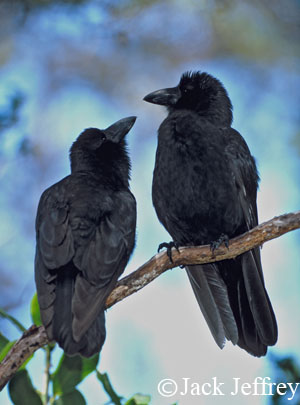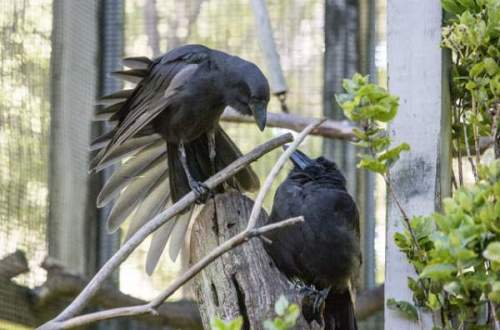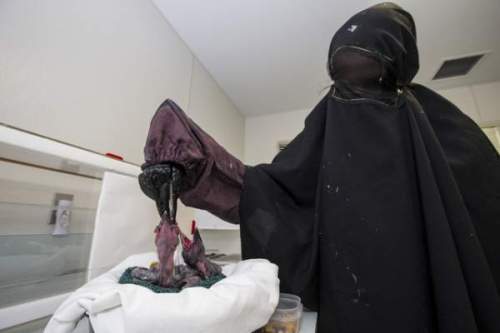It can be hard to imagine crows as anything but ubiquitous. During winter across the country, dusk marks the time where some cities see their skies turn black with thousands, even hundreds of thousands of American crows converging to roost. These crows have taken nearly all that people have thrown at them: deforestation, mass waste, and the urban sprawl that simplifies previously complex ecosystems, and uses it to their advantage. Not all species of crow have thrived in the Anthropocene, however.

Thousands of gather accumulate in the skies above UW’s Bothell campus in the winter

Photo c/o the Alala Restoration Project
Unlike their generalist, continental counterparts, the ‘Alalā is more specialized to feed on understory fruits and nuts and in fact were key seed distributors for many of Hawaii’s native plants. Island living also fostered a similar behavior seen in only one other species of crow: tool use. Like the New Caledonian crow, the ‘Alalā is a dexterous tool user, though the two species are only distantly related. Scientists believe this example of convergent evolution is fostered by aspects typical of islands, namely low predation and low competition for embedded food5.
Unfortunately, limited distributions and higher specialization also meant their population was more fragile than that of continental crows. Logging, agricultural development, loss of native pollinators, and alterations by non-native ungulates challenged both food acquisition and breeding habitat. Introduced diseases such as avian pox, malaria and the Toxoplasma gondii parasite carried by cats further weakened an already ailing population6,7. Invasive predators including rats, mongoose and cats consumed eggs, nestlings and fledglings. Finally, humans continued their tradition of persecution, particularly feral pig hunters who would shoot the birds before they could alarm call and scare off their prey2.
Together, these threats set into motion a decline in population we failed to recover despite some increases in research and management starting in the 1970’s. The last known wild egg was laid in 1996, and the last wild pair was seen in 20022,3. Some people did recognize the urgency of their decline prior to 2002, however, and a captive breeding population was started successfully rearing over 90 birds8. Although such a small number of breeders may raise red flags with respect to inbreeding and genetic depression, this is rarely as big of an issue as is commonly perceived. Unfortunately, light management and depredation by the also endangered Hawaiian hawk (‘io), decimated the released population and reintroduction efforts were halted in 1999 until a larger captive population and better management strategy could be devised.

Photo c/o Holly N Johnson/Tribune-Herald

A human dressed as an ‘Alala feeds captive reared nestlings. Photo c/o San Diego Zoo Global
While clearly disheartening, early hiccups in a release effort like this are not unusual and conservationists and biologists are not losing hope that success is still possible. Part of ensuring such success, however, is undoubtedly public support particularly with respect to maintaining the strength of the Endangered Species Act and support of the ‘Alalā Restoration Project. The perception that all crows are alike or that generous populations of American crows means protections for other corvus species is unwarranted or redundant will be a disaster for these rare birds. So make your voice heard when funding for conversations efforts come under fire, and share your passion for endangered corvus species with friends and family. The fate of the world’s rarest crow quite literally depends on it.

Two newly released ‘Alalas peer around their new surrounding in the Pu’u Maka’ala Natural Area Reserve. Photo c/o the San Diego Zoo Global
- https://www.fws.gov/pacificislands/fauna/alala.html
- Faike, E. 2006. Wild voices in captivity: the date of the ‘Alala. Birding 38: 64-67.
- Banko, P. C.; Burgett, J.; Conry, P. J.; David, R.; Derrickson, S.; Fitzpatrick, J.;
- National Research Council (US) Committee on Scientific Issues in the Endangered Species Act. Science and the Endangered Species Act. Washington (DC): National Academies Press (US); 1995. 2, Species Extinctions. Available from: https://www.ncbi.nlm.nih.gov/books/NBK232371/
- Rutz C, Klump BC, Komarczyk L, Leighton R, Kramer J, Wischnewski S, Sugasawa S, Morrissey MB, James R, St Clair JJH, Switzer RA, and Masuda BM. (2016).
Discovery of species-wide tool use in the Hawaiian crow. Nature 537: 403-407 doi:10.1038/nature19103
- Maxfield, B. 1998. Wild ‘Alala population suffers major setback. ‘Elepaio 58: 51.
- Liebermann, A.; Nelson, J. T.; Simmons, P.; Unger, K.; Vitousek, P. M. 2003. Draft revised recovery plan for the Alala (Corvus Hawaiiensis. US Fish and Wildlife Service, Portland, OR, USA.
- Lieberman, A. C., Kuehler, C. M. 2009. Captive propagation. In: Pratt, T. K.; Atkinson, C. T.; Banko, P. C.; Jacobi, J. D.; Woodworth, B. L. (ed.), Conservation Biology of Hawaiian Forest Birds: Implications for Island Avifauna, pp. 448-469. Yale University Press, New Haven.
- Valutis LL, and Marzluff JM. (1999). The appropriateness of puppet-rearing birds for reintroduction. Conservation Biology 13: 584-591
